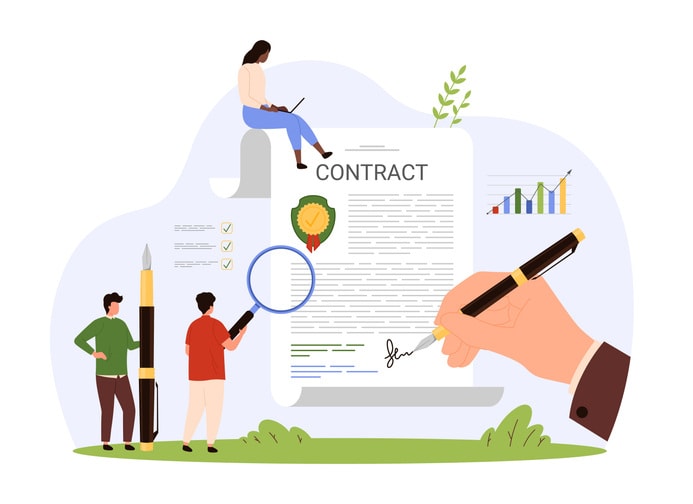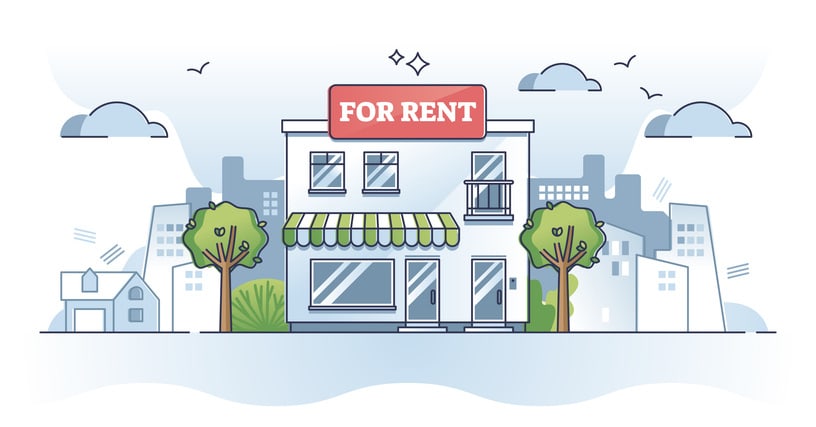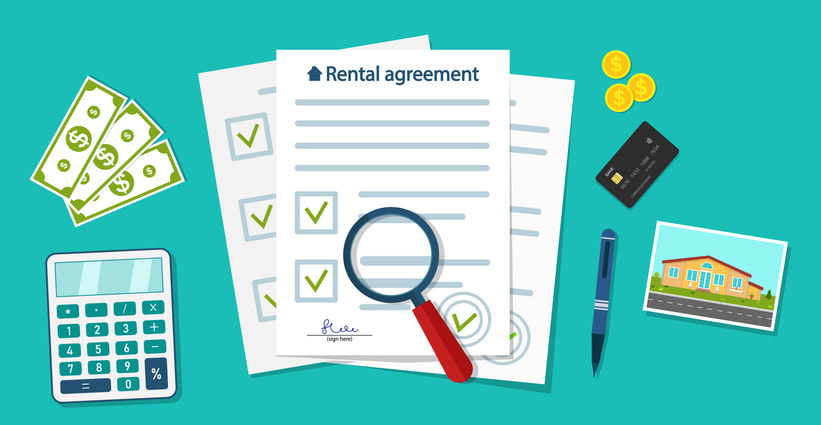Setting up or signing a lease agreement rental can be straightforward—no legal background is needed. What are your obligations as a tenant? What makes a lease legally sound for landlords? Discover these core aspects and more as we guide you through crafting a clear, enforceable rental lease agreement. Avoid common pitfalls and arm yourself with the know-how to navigate rental agreements confidently.
Key Takeaways
- A written lease agreement acts as a legally binding contract between landlord and tenant, providing clarity and reducing the risk of disputes over the terms of tenancy, and must include clear identification of the parties, a precise property description, and defined tenancy terms.
- Landlords and tenants can use customizable lease agreement templates as a starting point, modifying clauses to fit their specific needs. Having these customized agreements reviewed by an attorney to ensure compliance with relevant laws is advisable.
- Lease agreements encompass a wide range of responsibilities and rights for both tenants and landlords. They include financial details like rent structure, security deposit terms, and provisions for unforeseen circumstances such as early termination rules and the landlord’s right of entry.
Understanding lease and rental agreements

Kumospace is a great platform for building virtual office space, providing room for your remote teams to collaborate and work together. However, at some point, most businesses and employees will need to rent either domestic or commercial property for their business, be it office space or storage. For peace of mind, whatever the property, you’ll need a lease agreement.
A lease agreement is a legally binding contract between a landlord and a tenant to rent property in exchange for payment. Both lease and rental agreements serve the same purpose and contain similar information, which is crucial for establishing tenancy terms.
A properly executed lease agreement is like the backbone of your rental relationship. It provides protection for both landlords and tenants and may be legally required in certain cases. Relying on verbal agreements can lead to parties having different recollections of arrangements, potentially resulting in disagreements over rights and obligations. That’s why a written Residential Lease Agreement is your best bet. It minimizes risks and helps prevent disputes by clearly referencing the agreed terms.
In the United States, there is no legal distinction between a lease and a rental agreement, both of which create a legally binding contract. These agreements legally define the responsibilities of landlords and tenants, including those related to rent payment and property maintenance. By imposing significant legal obligations, lease agreements ensure a formal structure for the financial and maintenance-related responsibilities of each party.
So, understanding lease agreements is the first step towards a peaceful and legal tenancy, whether you are a tenant or a landlord.
The essentials of a residential lease agreement

Like a business operating agreement, there are various parts to a rental agreement. But not all lease agreements are created equal. Their content can vary significantly depending on the specific situation and the parties involved. However, all successful residential lease agreements share some common elements. These essentials include identifying the parties involved, providing a detailed property description, and outlining the tenancy terms.
Let’s delve deeper into these components.
Identifying the parties involved
The first step in drafting any agreement is to clearly identify the parties involved. In the case of a lease agreement, this means the landlord and tenant. The importance of this step cannot be overstated. It’s a simple yet crucial part of the process that ensures the agreement is legally enforceable.
This identification is not just limited to the landlord and the primary tenant. It’s crucial for short-term rental agreements to list all adult occupants with their full names and have them sign the agreement to ensure legal responsibility for compliance with the terms. Think of it as a roll call, ensuring every party to the tenancy is accounted for and held responsible.
Consider this: If a dispute arises or the property is damaged, a lease agreement that clearly identifies all parties can help resolve the issue more efficiently. It’s a preventive measure that can save everyone involved a lot of headaches down the road.
Property description and address
Equally important is the task of providing a precise and unambiguous property description in lease agreements to avoid uncertainty regarding the premises being rented. The devil is in the details, as they say. This couldn’t be truer than when it comes to describing the property in a lease agreement.
The lease agreement should include a detailed description of the property, such as:
- Its physical address
- Type of property
- Number of rooms
- Any included amenities
This will define clearly what is being leased. Including the property's full address in the lease agreement is crucial for accurately identifying the rental’s location.
Imagine renting a property only to discover that the landlord had mistakenly listed the wrong unit number. That’s why a comprehensive property description and the landlord’s address in the lease safeguard against disputes and ensure lease terms are clear to all parties involved.
Terms of tenancy
Tenancy terms refer to the lease's duration and the conditions under which it can be renewed or terminated. There are two primary forms of lease agreements: fixed-term leases, which have a set duration, and periodic leases, which do not have a specified end date.
Fixed-term leases, often lasting a year or more, offer stability by preventing alterations to rent and other conditions during the lease period. They have a predetermined start and end date, after which they can potentially convert to periodic tenancy if not renewed or terminated.
On the other hand, periodic leases, also known as tenancy-at-will, offer increased flexibility. They allow tenants and landlords the option to end the tenancy with proper notice, commonly 30 days. Monthly rental agreement renewals typically occur automatically unless either party provides notice, allowing for an ongoing tenancy without a fixed end date. This allows you to adapt your lease term in response to changing personal circumstances or needs.
Crafting your own lease agreement

Creating your own lease agreement might sound like a daunting task, but it is an empowering process. It allows you to tailor the agreement to your specific needs and gives you a better understanding of your rights and obligations as a landlord or tenant.
Let’s delve into how you can craft your own lease agreement.
As a legal document, you might want to share it with other tenants or the landlord. In the digital age, this is easily done with applications like Kumospace where you can go over the document and make corrections live before signing it.
Lease agreement templates
Creating a lease agreement from scratch can be daunting, especially if you’re new to it. But fret not. There are many lease agreement templates available online that can serve as a starting point for drafting your own lease. These templates are readily available and cater to different user preferences and software accessibility, such as PDF, Microsoft Word (files you can share with Microsoft Teams), and OpenDocument.
Using a lease agreement template as a foundation gives you a head start. It provides you with a basic structure, which you can modify to suit your specific needs. But remember, while a template can give you a good starting point, it’s important to customize it to reflect the specifics of your property and the agreement with your tenant.
Although templates make the process easier, it’s important to remember that creating a lease agreement is not a one-size-fits-all situation. Each property and tenant might require different terms and conditions. That’s why it’s essential to understand each clause and modify it according to your needs.
Customizing lease clauses
Once you have a lease agreement template in place, the next step is to customize the clauses to address your specific terms and conditions. Customizable clauses in a lease agreement can address matters like:
- Rent amounts
- Payment due dates
- Acceptable payment forms
- Late fees
- Security deposit terms
When customizing lease clauses, it’s important for each provision to be detailed and clearly understood by both parties to avoid future disputes and ensure enforceability. For instance, if your property has a strict no-pets policy, this should be explicitly stated in the lease agreement to avoid any confusion in the future.
Given the complexity of lease agreements, having an attorney review customized clauses can help identify potential legal issues and ensure that the clauses comply with relevant laws. This way, you can ensure that your lease agreement is tailored to your needs and legally sound.
Financial aspects of lease agreements

Money matters are always delicate, and when it comes to lease agreements, they are of prime importance. A comprehensive lease agreement must outline the financial aspects, including rent payment structure and security deposit laws, to avoid misunderstandings and ensure transparency.
Monthly rent payment structure
The rent payment structure is one of the most crucial aspects of any lease agreement. The lease agreement must specify the exact rental amount and the due date for monthly rent payments. This clarity ensures that both the tenant and landlord have a clear understanding of their financial obligations.
Also, lease agreements should include a provision for the accepted rent payment methods, such as check, electronic transfer, or other agreed-upon methods. This provision helps avoid any confusion or disagreement over the method of payment.
It’s also worth noting that landlords are permitted to collect rent and impose late fees in accordance with the agreement and may adjust the rent according to the terms outlined within the lease. This ensures that both parties know the potential for changes in the rent amount and can plan accordingly.
Security deposit laws and best practices
Security deposits, also known as tenant’s security deposits, are another key financial aspect of lease agreements. These deposits, collected at the start of the lease, act as a financial safety measure to cover potential damages or defaults. But did you know that each state has specific rules and regulations regarding the collection and handling of security deposits?
For instance, some states may require deposits to be held in interest-accruing accounts, while others impose limits on the deposit amount. This is why it’s crucial to understand your state’s specific laws regarding security deposits when drafting your lease agreement.
Lastly, lease agreements must explicitly outline the terms related to security deposits. This should detail:
- the amount
- allowable uses
- return conditions
- the process for documenting the property’s condition
- handling pet-related damage if applicable
This way, both parties know what the security deposit covers and how it is handled.
Rights and responsibilities in a lease agreement

A lease agreement isn’t just about financial terms and property descriptions. It’s also about understanding the landlord's and tenant's rights and responsibilities.
Let’s delve into these aspects.
Landlord's obligations
One of a landlord’s primary obligations is to ensure the rental property is habitable. This includes performing regular maintenance, handling infestations, and managing security deposits. But what does “habitable” really mean?
In a lease agreement, habitability refers to the property being in a condition fit for human habitation. This means maintaining vital services such as plumbing, electricity, and heating. In other words, landlords need to ensure their property is safe and comfortable for tenants to live in.
Apart from maintenance, landlords also have a responsibility towards tenant safety. This includes screening tenants, maintaining secure locks, and equipping the property with safety devices such as smoke detectors. In addition, landlords must address repair issues, responding to major problems urgently, often within 24 hours, and also attending to minor repairs promptly. A property manager can greatly assist in ensuring these responsibilities are met.
Lastly, landlords must detail their right to access the property, specifying the conditions and required notice for entry, in the lease agreement. This ensures that the tenant’s right to privacy is respected while also allowing the landlord to carry out their obligations.
Tenant's responsibilities
Just as a landlord has obligations, tenants have their share of responsibilities. One of the primary responsibilities of tenants is to:
- Keep the property clean
- Uphold the general upkeep throughout the duration of their tenancy
- Not cause any unnecessary damage to the property
- Keep the property in a condition similar to when they first moved in.
In addition, tenants are expected to:
- Promptly report any issues or necessary repairs to the landlord
- This not only helps maintain the property but also prevents small issues from becoming major problems
- For instance, a leaky pipe may seem minor, but if left unattended, it could lead to significant water damage.
At the end of the tenancy, tenants must return the property cleanly. Any abandoned personal property may be claimed by the landlord. Therefore, it’s essential for tenants to remove all their belongings and clean the property before moving out.
Finally, tenants with pets have additional responsibilities. They are responsible for controlling their pets, and cleaning up after them, and may be required to have renters’ liability insurance including coverage for pet incidents. This not only ensures the property is kept clean but also protects the landlord from potential liabilities due to pet-related incidents.
Additional provisions and addendums

While the core elements of a lease agreement are crucial, additional provisions and addendums can be included to cover special conditions, such as pet policies and renewal options.
Let’s delve deeper into these additional elements.
Handling personal property
When it comes to using property amenities such as pools or gyms, the handling of personal property can be a source of contention. Lease addendums can establish guidelines for tenants regarding the use of these amenities and the handling of their personal property within these areas.
Imagine a scenario where a tenant leaves their personal belongings in a communal gym, causing inconvenience to other residents. Having a clause that addresses the handling of personal property can prevent such issues. It can clarify rules about where personal belongings should be stored, how shared amenities should be used, and what happens if these rules are not followed.
By outlining these rules in the lease agreement, both the landlord and tenant can be assured that there are clear guidelines to follow. This not only prevents disputes but also ensures that communal spaces can be enjoyed by all residents.
Renewal and termination options
Another key aspect of a lease agreement is the terms related to renewal and termination. Lease agreements should include explicit sections on these options to ensure clarity and understanding between the landlord and tenant.
Renewal options may incorporate an automatic renewal clause or provisions for lease extensions through addenda that address temporary adjustments, like during property renovations or specific occasions. Similarly, lease termination procedures must be outlined in the agreement, detailing the advance notice required and specific conditions that allow either the landlord or the tenant to terminate the lease.
Including these options in your lease agreement allows tenants to adapt their lease terms in response to changing personal circumstances or needs. It also assures landlords that they know under what conditions the lease can be terminated or renewed.
Preparing for unforeseen circumstances

Planning for the unexpected is a critical part of drafting a lease agreement. Unforeseen circumstances, including early termination and subletting rules, can affect both landlords and tenants. Thus, preparing for these possibilities is essential.
Early termination and subletting rules
Life is full of surprises, and sometimes these surprises may require tenants to terminate their lease early. That’s why leases often contain early termination clauses that specify conditions under which tenants may terminate their lease before the end date. Such clauses can provide flexibility for the tenant while also protecting the landlord from sudden vacancies.
Tenants may also wish to sublet their rental units. If allowed by their lease agreement, tenants can sublet, but they typically remain responsible for the property and tenant rent payments. This means that even if you sublet your rental, you still have obligations to your landlord.
Another option for tenants is reletting, which involves finding a new renter who signs a new agreement with the landlord, releasing the original tenant from their obligations. Whether a tenant can sublet or relet their rental depends on the terms of their lease agreement, so it’s essential to check your agreement before considering these options.
Landlord's right to enter
While a landlord owns the property, they can’t just walk in whenever they please. The landlord’s right to access the rental unit must be defined within the lease agreement to ensure that the tenant’s right to privacy is respected.
In most cases, landlords must provide reasonable notice before entering a tenant’s dwelling for non-emergency reasons. The specific notice period should be clearly established in the lease agreement. These reasons can include routine inspections, repairs, or showing the property to prospective tenants or buyers.
However, there are specific conditions under which the landlord may enter the property without the standard notice. These include emergencies or urgent repairs. These entry provisions protect the tenant’s right to privacy and the landlord’s ability to maintain the property adequately.
Legal considerations and compliance

The legal considerations of a lease agreement are a critical aspect that must not be overlooked. State-specific landlord-tenant laws govern lease agreements and the landlord-tenant relationship, necessitating compliance within lease agreements. This means that lease agreements must align with the state's laws where the property is located.
Aside from complying with state laws, lease agreements can also include arbitration clauses. These clauses provide an efficient and cost-effective way to resolve disputes outside of court. This can save both the landlord and tenant time and money in the event of a dispute.
What happens when a tenant refuses entry to the landlord after proper notice? In such cases, landlords have legal measures such as mediation or eviction proceedings at their disposal. This highlights the importance of understanding your legal rights and obligations as a landlord or tenant.
While state laws do not standardize a maximum late rent charge, it’s essential to consider such laws when drafting lease agreement financial terms. This ensures that any late fees charged are legal and fair.
Finally, lease agreements must include legal disclosures, informing tenants about specific aspects of the property when required by law. These could include information about lead-based paint in older properties or potential flood risks in certain areas.
Using lease agreements for various property types

Lease agreements are not just for residential properties. They can be adapted for various property types, including residential or commercial property, from commercial spaces to vacation rentals.
Let’s explore how lease agreements can be tailored for different types of properties. Note that with commercial rents soaring in many parts of the world, taking your business remote or working as a digital nomad can be a quick and low-cost solution.
For startups, there is no need to rent property, using the likes of Kumospace as a remote virtual office space can create an online space for collaborative teamwork.
Residential vs. commercial leases
Residential and commercial leases have many similarities, but they also have some key differences. Residential leases are usually short-term, ranging from six months to one year, while commercial leases tend to be longer, often covering a span of three to five years or more.
If you can’t find the right space, a virtual co-working space is one solution. Commercial leases are often much more detailed than residential leases, tailored to support various business activities. Residential leases emphasize the well-being and residential use of the occupants. Moreover, commercial tenants may have more leeway in negotiating lease agreement terms than residential tenants.
Another key difference is rent control protections. Unlike residential leases, commercial leases may not offer the same rent control protections, allowing for more flexibility in rent increases from landlords. These differences highlight the need for tailored lease agreements to suit the specific needs of different types of properties.
As part of business continuity plans, companies may need to rent space at short notice, but still need to ensure the rental agreement meets their needs.
Short-term rental agreement specifics
Short-term rental agreements, like those used for vacation rentals, have their own specifics. Such agreements must explicitly outline the accurate rental periods to prevent confusion and ensure the document remains valid.
Short-term rental agreements are often more detailed than regular lease agreements to cover the specifics of short-term rentals. These might include detailed rules about property use, additional fees for amenities, and strict check-in and check-out times.
In addition, short-term rental agreements also need to protect against the unintentional establishment of long-term tenancy rights. For example, a short-term rental agreement might contain a clause stating that the agreement does not create a long-term tenancy. This ensures that the intended nature of the short-term rental is preserved, and the tenant does not gain long-term tenancy rights.
Tools and resources for landlords and tenants

Whether you’re a seasoned landlord or a first-time tenant, the world of lease agreements can seem overwhelming. But don’t worry. There are plenty of tools and resources available to help you navigate this landscape.
Sample lease agreement documents are important resources for landlords and tenants looking to create or review lease agreements. These sample documents provide a blueprint that you can follow, making the process of drafting a lease agreement much easier. These samples can be obtained in multiple formats, such as PDF or Word files, accommodating various needs for editing and sharing.
But what if you’re a landlord looking to attract potential tenants? Online real estate platforms offer landlords tools to market their rental properties effectively. These platforms can enhance the visibility of your property and attract potential tenants.
The internet is a treasure trove of information about lease agreements. Various websites offer detailed guides on different aspects of lease agreements, from basic terminologies to legal requirements. There are also online forums where landlords and tenants can share their experiences and offer advice.
Remember, while these tools and resources can be extremely helpful, they do not replace professional legal advice. Whenever in doubt, it’s best to consult with a legal professional to ensure your lease agreement is legally sound and protects your interests.
Summary
Through this journey, we’ve unraveled the complexities of lease agreements and explored various aspects, from their basic structure to legal considerations. We’ve learned that a lease agreement is not just a piece of paper, but a legally binding document that lays the foundation for a healthy landlord-tenant relationship. Whether you’re a landlord drafting your own lease agreement or a tenant seeking to understand your rights, remember that knowledge is your greatest ally. So, continue to educate yourself, seek professional advice when needed, and navigate your leasing journey with confidence.
Frequently Asked Questions
In the United States, there is no legal distinction between a lease and a rental agreement; both serve the same purpose and create a legally binding contract.
Yes, you can create your own lease agreement using templates as a starting point, but it's important to have a legal professional review the document for legality and completeness.
The key financial aspects of a lease agreement encompass the rent amount, due date, accepted payment methods, and terms related to security deposits, all of which should be clearly outlined in the agreement for transparency.
The main difference between residential and commercial leases is that residential leases are usually short-term, while commercial leases tend to be longer and more detailed, tailored to support various business activities. If you need to leave a commercial property due to the end of a lease or change in circumstances, Kumospace provides a great way to create a virtual office for your teams.
Yes, there are various tools and resources like sample lease agreement documents and online real estate platforms available for landlords and tenants to utilize in creating or reviewing lease agreements and marketing rental properties.





